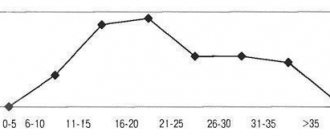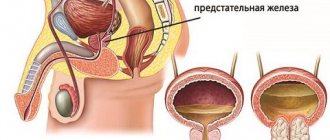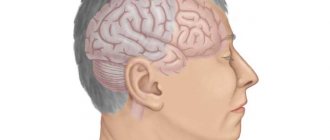A survey was recently conducted on why people don’t like visiting doctors so much. Even with serious symptoms, alarming signs of illness, a person reluctantly goes for help to people in white coats. The answer was stunning. It turns out that 45% of respondents are simply afraid to hear a terrible diagnosis. In second place is fear for one’s health due to the negligent treatment of some doctors. The remaining part of the respondents prefer to be treated independently or with the help of traditional medicine. Well, that's an interesting observation. However, there are diseases that cannot be cured with herbs, poultices, and leeches. Brain tumor, how long do you live with it? How many happy, calm, joyful days are measured out for a person who has heard such a diagnosis?
Even 50 years ago, patients with a similar diagnosis, leaving the doctor, could safely go home, waiting for their last hour. Time passes, medicine has made great strides forward, new drugs have appeared that help fight previously incurable diseases. Most clinics are equipped with the latest technologies that make it possible to identify the source of tumors at the earliest, first stages. Science has advanced significantly, but people still have fear of the disease. After all, such a phrase as “inoperable brain tumor” leaves virtually no chance of continuing the same life. Or is there still hope?
You need to know the enemy by sight
What is a brain tumor, cancer, head oncology? This is a terrible disease that affects the main organ - the brain, the head or its individual parts. A broken arm or leg can be healed. A diseased internal organ can be cured or, in extreme cases, transplantation can come to the rescue. People can live with one kidney, without a spleen, with an artificial heart, but none of them can live without a brain. It is he who is the most important organ. Thanks to him, a person remains himself, moves, breathes, talks, thinks, remembers his past, can plan the future, works in the present. A brain tumor, with its very appearance, erases your entire life, takes away memories, fills existence with pain, fear, and hopelessness. In fact, with further progression, the neoplasm in the head turns the patient into a motionless doll, and, in the language of modern times, into a vegetable.
Naturally, having heard such a diagnosis, the patient begins to prepare in advance for the worst, says goodbye to loved ones, acquaintances, and relatives. He surrenders to the mercy of the disease - mistake No. 1. The patient immediately asks the question why he became the victim of an unfair fate, completely ignoring the reasons why the tumor appeared. This is mistake number 2. To fight, first of all, you need to know your enemy.
A malignant tumor is the result of sudden, uncontrolled cell division. Every day hundreds of small particles are born in the body. They live, mature, die - the natural process through which a person exists. Malignant cells are common, but the immune system prevents them from growing in the body by destroying them. But one day, under the influence of viruses and infections, the immune system weakens and protective barriers fall sharply. During such periods, people feel a loss of strength and often get sick. This is why vitamins, rest, and fruits are so necessary. Malignant cells begin to grow sharply, and certain factors also help them:
- radiation exposure;
- bad ecology;
- preservatives, chemicals, carcinogens;
- GMO products;
- living near power lines;
- constant stress, depression, nervous breakdowns, negative environment;
- heredity;
- bad habits.
Such reasons cause particles to “go crazy.” The body is unable to cope with division, and the process of neoplasm growth begins. Gradually, aggressive cells invade neighboring tissues, destroying them; all signs point to a tumor. Tumors exhibit the following symptoms:
- Weight loss.
- Headache, intensifying at night in the morning.
- Attacks of loss of consciousness, paralysis of individual organs of the body.
- Insomnia or, conversely, a constant desire to sleep.
- Numbness of some areas of the skin and body.
- Distortion of the mouth, eyes, eyelids.
- Constant fatigue, depression, nervousness, phobias.
- Hallucinations: sound, olfactory, auditory, visions.
- The vestibular system is severely disturbed: the gait changes, the orientation in space is lost.
- Deterioration of vision, loss of vision, cloudy veil before the eyes, the effect of floaters.
- Changes in memory: some fragments fall out, elementary names of things, names, events are forgotten. Formation of false memories.
- Nausea during painful attacks.
- Manifestation of aggression and inappropriate behavior.
- Intracranial pressure is sharply increased.
Most of the moments can be attributed to everyday fatigue, which is present in almost every working person. That is why many people ignore the first important symptoms of the disease, preferring to be treated with painkillers and sedatives. Poor vision is improved with lenses and glasses; hallucinations and memory loss are treated with sedative herbs. Meanwhile, vital minutes are running out, and the disease is seizing new territories.
Causes
The formation and further growth of a tumor in the brain is still not fully understood. Basically, conclusions about the causes were based on numerous studies of existing clinical situations.
To date, the main reasons provoking the growth of a malignant tumor have been identified:
- Genetic factor.
- age
. Most often, the pathology develops rapidly in old age from 65 to 80 years. But in some cases, voluminous and active growth is observed in children under 8 years of age. - Gender
of the patient. Oddly enough, the growth of the tumor is influenced by the gender of the patient. The most active tumors in this regard are brain tumors and men. Although some types of head cancer are more common in women, they are characterized by a slight increase in volume. - Exposure to X-ray
radiation. In this case, the targeted receipt of high doses during radiation therapy is considered. In patients who have undergone this type of treatment, the development of a brain tumor is observed in 10% of cases. In this case, the growth can be delayed and diagnosed either after 5 or 15 years. - Professional activity
associated with hazardous production, in which a person regularly has to deal with arsenic, nuclear exposure, mercury, and pesticides. These substances can serve as a catalyst that provokes the synthesis of new malignant cells. - Weakening of the immune system
, as a result of which the growth and spread of cancer throughout the body is activated.
Disruption of certain genes leads to activation of the epidermal growth receptor, which is responsible for stimulating the formation of cells, including cancer cells.
This reaction causes uncontrolled growth of cancer. According to statistics, a genetic factor provokes tumor growth in 10% of cases. At the same time, genetic deformation is in no way connected with heredity.
The famous singer Zhanna Friske died from an inoperable stage 4 brain tumor; assumptions about what caused the formation of cancer in a physically strong woman are in this video:
Diagnosis and prognosis
Doctors divide oncology into 4 stages. Depending on the point at which the patient went to the doctor, treatment is prescribed, and a prognosis is made:
- At first, when the patient comes to the doctor with mild symptoms, it is possible to identify the localization and carry out successful treatment, possibly through surgery. The percentage that the patient will live is 80–90%. This is the first, initial stage.
- The second, serious stage is characterized by severe pain, paralysis of the body, and facial asymmetry. Inside, cells divide very quickly, affecting neighboring tissues. The neoplasm is actively growing, strangling neighboring organs. Surgery is scheduled to remove a brain tumor. If the patient has crossed the sixty-year mark, the chances that he will live for a long time are greatly reduced. The body simply cannot withstand a long fight against cancer and courses of mandatory chemotherapy.
- The third stage is characterized by the large size of the tumor, severe swelling of neighboring organs appears. Brain surgery is suggested, but in many cases the tumor is considered inoperable. The patient is given a couple of years to live.
- At the last, fourth stage, all tumors are considered unresectable. This means that the metastases have penetrated into neighboring organs, the chance of survival is no more than 5–6%, however, these percentages still exist. Brain surgery is performed only if it is possible to alleviate the patient's suffering.
Removal of a brain tumor depends not only on the stage; there are a number of criteria: the size of the tumor, location, type of tumor, general condition of the person. Each item has its own contraindications or recommendations. If the focus is located in organs responsible for vital functions, then surgery to remove a brain tumor will be a big question. Neoplasms are not removed if their size is more than 7–8 cm in diameter, lymphomas, diffuse neoplasms located near the brain center.
The presence of a dangerous lesion can be determined not only by symptoms; computed tomography, magnetic resonance imaging, and radiography come to the aid of doctors. The latter method determines damage to the bones of the skull, sutures, and vault. Ultrasonography diagnoses formations in tiny patients up to one year old. After confirming the diagnosis, a verdict on the treatment program is made, and surgical options are considered. Removing a brain tumor takes more than one hour. Complications, difficulties, and death are possible during the procedure itself. The first question for patients is how long do they live with a brain tumor? One does not live with a malignant disease: it is treated. Moreover, the sooner the patient goes to the clinic, the higher the success of the operation itself. There are fewer complications in the postoperative period, and accordingly, the years of a person’s life are extended.
Cancer stage
There is definitely no chance of a complete cure in the fourth stage of the disease. The patient’s loved ones should try to accept the inevitable and come to terms with it. The goal is not recovery, but prolongation of life and improvement of its quality. For this purpose, radiation therapy is used, since surgical intervention at this stage is no longer acceptable - there has been too much infiltration of the brain tissue by tumor cells.
How long do people live with this diagnosis? Just a few months. With rare exceptions, cancer can allow you to survive in the world of the living for a couple of years.
Only a few cross the five-year border; this can be called a miracle.
The main factors influencing survival are the type of tumor and its location
At the third stage, the situation is better: the life span is extended to two to three years. Operations are performed, but rarely, only when the cancer is successfully localized close to the bone. Existing experimental treatments will soon make it possible to treat cancer at this stage, but for now these are future prospects and not actual medical practice.
The first and second stages are characterized by the mildest course. At these stages, surgery under the supervision of a qualified neurosurgeon is indicated. Cancer penetrates deep into the nerve tissue, so the removal of the malignant formation is carried out with the capture of healthy tissue. The doctor must ensure that the surgery does not damage cognitive function and that the quality of life for the remaining period is acceptable. Patients will also be pleased with information about how long they live when therapy is started at these stages. From five years and above, subject to all doctor's instructions.
Treatment methods
Symptoms may not appear for a long time or may be so minor that a person simply does not notice them. Head cancer is a very insidious disease. It is carefully disguised as migraines, hypertension, and depression. Tumor symptoms may not be observed until the third stage of oncology. Such patients often do not even suspect the presence of the disease. The last stages of cancer are very aggressive: metastases appear. But even in this state of affairs there is a chance to save lives.
Laser exposure will help if the lesion is located on the surface, in the nerve fibers. Its action is aimed at removing malignant areas. In hopeless cases, laser treatment brings little relief.
Radiation irradiation is used specifically in inoperable cases of brain cancer. How long they live after such a procedure depends on the general condition of the patient and the effectiveness of the action. In especially severe cases, external three-dimensional conformal action is used: 5 days of radiation treatment, 2 days of rest. There are 6 courses in total. A correctly calculated radiation dose will stop the growth of the lesion and reduce it, which significantly increases a person’s chances of recovery.
A cyber knife, or laser gamma knife, will allow you to remove tumors that are inaccessible to scalpels. The brain tumor remains after the operation, the knives destroy the DNA of harmful cells - the lesion will shrink on its own. An excellent method, however, it cannot be used for large formations.
During endoscopy, the tumor itself is removed through a small hole using electric tweezers and a pump. Craniotomy is an operation for a brain tumor; its consequences can be swelling and the formation of cysts.
Forecast
Inoperable brain tumor is a disease with a high fatal outcome. For older people, the prognosis for stage 4 cancer is disappointing - a few months to live. At a young age, the body is able to resist disease much longer. Modern treatment methods prolong the lives of patients. With glioblastoma, a survival rate of 5 years is recorded in 14% of cases.
What is inoperable cancer?
After the sentinel event, persistent limitations in physical and cognitive functioning and quality of life prevail and cause additional challenges for family caregivers.
-. The needs of patients with a brain tumor differ from those of other cancer patients and are often not met by existing resources. Fox and Lantz conducted a quality of life study using individual and group interviews with support groups. Their findings were organized into the following conceptual themes: mind-body disease stigma, invasive disease of the self, brain tumor as a familial disease, related to the medical system and quality of life. To summarize, let us recall that stage 4 cancer is a dangerous and serious disease. A neurologist should be consulted for early symptoms such as headache, uncontrolled vomiting, and loss of balance. To treat an inoperable tumor, modern medicine uses non-invasive and effective radiosurgery techniques - Cyber Knife and Gamma Knife. The use of techniques makes it possible to prolong the life of seriously ill patients.
Unconventional methods of treating inoperable tumors
They also reported topics that included changes in family life and managing medical advice. The theme of “the long walk” highlighted unexpected challenges and challenges, quality of life, resource needs, provider burnout, and balancing hope with realistic expectations. The search for information has become a separate topic.
Treatment of terminal stages of brain cancer
Their model assumes a continuous feedback loop as family caregivers assess caregiving needs and resources and describe factors that influence the stress response to caregiving. Research on information needs and chronic illness shows that almost all cancer patients want to be fully informed about various aspects of their disease and treatment and are increasingly taking an active role in their own care. “However, a number of large retrospective surveys have found high levels of dissatisfaction among patients and their families with the information they received after a cancer diagnosis.
What remedy for headaches, migraines and stress do many doctors still not know about?!
- Do you suffer from occasional or regular headaches?
- Does it press and squeeze your head, eyes, or does it “hit you with a sledgehammer” on the back of your head, knocking on your temples?
- Do you sometimes feel nauseous and dizzy when you have a headache?
- Everything starts to irritate, it becomes impossible to work!
- Do you take out your irritability on your loved ones and colleagues?
At the beginning of 2020, scientists developed an innovative remedy that eliminates all these problems!
Civil and military airline pilots are already using this newest remedy to prevent and treat headache attacks, changes in atmospheric pressure, and protection from stress. Click on the link and find out about it in a special issue of the program “Live Healthy!” with famous experts. A brain tumor always sounds like a death sentence for a patient. But thanks to the latest treatment methods, this pathology can be stopped in most cases.
Because information needs arise with a patient's condition, patients and caregivers are unlikely to know all of their information needs during an office visit. Oncologists may not be prepared to support patients with the range of quality health care services that caregivers may need in palliative care, pain management, quality of life care, family issues, psychosocial issues, home care, managed care, and complementary and alternative medicine.
According to statistics, more than 80% of patients have a chance of recovery. The only exception is an inoperable tumor, which requires a special approach to treatment.
A brain tumor is considered one of the most dangerous to human life, and its malignancy does not always play a definitive role.
According to experts, a benign tumor located in the dangerous area of the head
or having voluminous growth.
A growing body of research shows that when patients and families better understand their diagnosis and treatment, they are more able to cope with their illness, use the health care system more effectively, and experience less psychological distress. Improved coping strategies, in turn, generally lead to better adjustment to a cancer diagnosis. However, there is insufficient research to explain how best to achieve this understanding for patients and their families. Health education theory suggests that just because information is available does not mean it is in a format that will be useful.
The difference from a malignant tumor mainly consists of the possibility of its metastasis and deterioration of the general clinical situation. One of the main treatments for brain tumors is surgical removal. But it cannot be used
if the tumor is considered inoperable.
Inoperable tumors include advanced stages of neoplasms that are in the active phase
metastasis. This type of tumor can act as a primary tumor or represent a secondary tumor. In both cases, the operation is not performed due to the high probability of death.
Most often, inoperable tumors include stage 4
.
But in some cases, stage 3 cancer is aggravated by the poor general condition of the patient or is located near the main vessels
of the brain.
Life after surgery
Recovery after major operations takes a long time. The patient will need a lot of effort and time to put his body in order. Rehabilitation after removal of a brain tumor will last more than one month. A new period of life will begin. The patient must completely abandon all bad habits, change their lifestyle, and practically learn to live again. Postoperative treatment and a course of chemotherapy will force you to go through unpleasant moments: hair loss, brittle nails, cracked skin - just a small part of what awaits you after radiation courses. Unfortunately, such methods cannot be canceled: medicine has not yet come up with other ways to treat oncology.
The diet will accompany a person throughout his life. Smoked foods, salted foods, tea, coffee, spices, and meat are prohibited. Sun tanning is also prohibited. Overwork, stress, and anxiety can only renew the malignant process. The morale of the patient is very important. In such terrible moments, loved ones can turn away and leave the person alone with the illness, and this is the closest path to the end. Doctors observe a paradox: patients who are in a fighting spirit, with a desire to live, fight, and not give up, can actually win back years of life from a fatal illness. Moreover, such cases are not uncommon in the final, fatal stages.
Brain tumor and how long do you live with it? It is impossible to completely defeat a fatal disease, especially if the disease is in the third or fourth stage. The patient can only win a couple of years in a difficult battle for life. The second stage will give more time, subject to careful treatment, compliance with all rules, routine, and medication. The first stage is curable. The patient can look forward to a long and happy life.
Oncology is rightfully considered the most serious disease. All efforts of doctors and scientists are aimed at studying cancer. Many people are working to create a unique cure against it. And yet the first step towards recovery must be taken by the patient himself.
Types of tumors
The brain is an extremely vulnerable and delicate organ. Any interference with its functioning can lead to irreversible consequences. Most often, children suffer from this anomaly. This disease at an early age ranks second after leukemia. Next come the men. The formations are least likely to be diagnosed in women.
Types of neoplasia:
- sepratentorial and infratentorial ependyomas;
- glioma of the optic pathways, brain stem;
- cerebellar or cerebral astrocytoma;
- craniopharyngioma;
- medulloblastoma;
- pinealoma is a tumor of the pineal gland.
Let's tell you a little more about the pathological degeneration of cells.
- Glioma. One of the most common tumors. It has signs of both benignity and malignancy. Most often found in children. If hemorrhages, necrosis, or cysts appear, patients live no more than three months. May exhibit diffuse growth. This process significantly complicates surgical intervention. Occurs in 55% of all cases.
- Meningioma is a meningeal tumor growing from the blood vessels of the brain. A very common type of cancer. In cases of significant growth and displacement of other parts of the brain, edema, urgent surgery is required to remove the tumor. Meningiomas account for 20% of all diseases.
- Adenoma is a tumor of glandular tissue in the pituitary gland. Occurs against the background of hormonal disruptions in the human body. They are allocated 25% of all cases.
- Neuroma - originates along the nerve endings of the skull. The auditory nerve is most often affected.
- Hemangioblastoma is a benign neoplasm in blood vessels.
- Teratoma. It is congenital and appears in the earliest embryonic development. Leads to an increase in blood pressure, which increases when the baby is crying or under other stress. 15% of patients suffer from this form of tumor.
- Cyst. It has the shape of a bubble with accumulated liquid in it. Formed between the structural components of the brain. It is a consequence of injuries, hemorrhages and inflammatory processes. May lead to compression of the cerebral cortex.
- Nodes of metastasis from other organs - mammary glands, kidneys and lungs. They occupy about 5% of neoplasms.
All these pathologies limit the normal functioning of the brain and are expressed in severe symptoms. How many reasons do cell mutations occur, and what are they?
How to prolong a patient's life
When choosing a treatment method, it is necessary to take into account the form of the pathology, the size of the tumor and the stage of its development, the individual characteristics of the human body, his state of health, and age.
In the initial stages, the patient is prescribed surgery. It is good if the tumor has clear boundaries, small size, and accessible location. In this case, surgical intervention gives the most positive effect.
Along with surgical treatment, drug therapy is also used. It is necessary to take antibacterial drugs to prevent secondary infection and painkillers.
On this topic
Who needs to be tested for tumor markers for brain cancer?
- Olga Vladimirovna Khazova
- May 27, 2020
The terminal stages of neoplasm development cannot be eliminated with surgical intervention. Nevertheless, surgery is still prescribed. During this treatment, only part of the tumor is removed. This allows you to slightly reduce pain and alleviate the patient’s condition.
Radiation therapy is a mandatory procedure. For small tumors, the ion flow is directed directly to the tumor body. If the tumor is large and there are metastases, irradiation is carried out systemically. Exposure to ion radiation makes it possible to stop the pathological division of tumor cells and reduce the growth rate of tumors.
The complex of therapeutic measures also includes chemotherapy, that is, taking antitumor drugs that kill pathological cells and stop their division. These drugs have a toxic effect not only on the tumor body, but also on healthy cells of the body. Therefore, the use of chemotherapy drugs leads to numerous side effects.
Along with antitumor drugs, it is necessary to take other medications. These are antiemetics, diuretics (which allow you to remove excess fluid from the body and relieve swelling of the brain), painkillers and tranquilizers.










